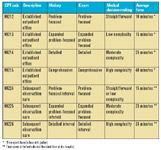Article
Clarifying codes for follow-up services; Billing for discharge services; Modifier use with code 20610
Learn the nuances of various follow-up codes.

Key Points

A: First, let me clarify the similarities of these groups of codes.
According to American Medical Association and Current Procedural Terminology (CPT) guidelines, all of these codes are follow-up codes that require two of three elements (history, exam, and medical decision-making) be met or exceeded to bill for the specified level. These codes also represent follow-up services.
• Place of service. Since the new subsequent outpatient care codes were introduced this year, established outpatient office codes (99211–99215) should be billed only when the services are performed in a physician office or other outpatient facility (place of service [POS] 11). Subsequent outpatient care codes (99224–99226) now should be billed for a patient in a hospital setting who has been placed in outpatient status (POS 22).
Before billing, be careful to double-check that the patient has not been admitted to the hospital. Subsequent hospital care codes (99231–99233) should be billed once a patient has been admitted.
• Interval history. An interval history is an update to the previous history taken. According to the 1995 and 1997 evaluation/management (E/M) guidelines, certain categories of E/M services (for instance, subsequent hospital care, follow-up inpatient consultations, and subsequent nursing facility care) include only an interval history. For these codes, it is not necessary to record information about the patient's past, family and social history (PFSH).






